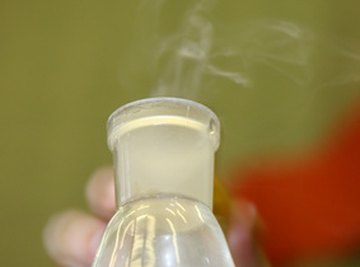
Pollutant results don't always use the same units. Comparing reports when results are shown in ppm, mg/m3 or ppmv can be challenging. But converting between these units requires just a few steps and a little background knowledge.
Defining the Term: PPM
The acronym ppm means parts per million. One part per million means one particle of a substance among a million total particles. Parts per million refers to the number of particles in a fluid, whether the fluid is gas or liquid. The full acronym should be ppmv, or parts per million by volume, but reports frequently drop the v to change from ppmv to ppm.
In soils, parts per million means parts per million by mass, abbreviated ppmm or ppmm. In gases, parts per million equals the number of moles of material (one mole of a substance equals 6.022x1023 units of the substance). When the carbon dioxide level in the atmosphere is reported as 409 ppm, the atmosphere contains 409 moles of carbon dioxide in a million moles of air.
The reverse conversion, from moles to parts per million (mol to ppm), means that the number of moles per million moles of substance equals parts per million.
Parts per million, a dimensionless quantity and measurement, describes very small concentrations of a material in air or liquids. Even smaller quantities may be reported as parts per billion (ppb). The acronym ppt may be used but ppt can mean parts per thousand or parts per trillion.
Defining the Term: Vapor Pressure
Vapor pressure refers to the pressure of a vapor (gas) above its liquid or solid phase when the two are in equilibrium in a closed container. Equilibrium occurs when the number of atoms or molecules evaporating equals the number of atoms or molecules condensing back to the liquid or solid.
Vapor pressure changes directly with temperature. When temperature increases, vapor pressure increases and when temperature decreases, vapor pressure decreases.Vapor pressure is measured using a mercury manometer.
When both sides of the manometer are open, a column of mercury in the U-shaped manometer tube will have equal height in each upright section of the tube. A closed container containing the material being tested is attached to one side of the tube. As the vapor pressure in the closed container increases, the pressure from the vapor pushes the column of mercury which then rises on the open side of the tube.
When the vapor pressure stabilizes, the difference in mercury levels on the two sides of the manometer shows the vapor pressure, reported in millimeters of mercury (mmHg or torr).
Partial Pressure
Vapor pressure is measured when only one type of gas is present. Partial pressure means the pressure of one gas in a mixture of gases. For example, when a person blows up a balloon, the balloon contains several different gases including carbon dioxide, oxygen, nitrogen, argon and water vapor. Each of these gases applies a partial pressure against the balloon. The combined partial pressures keep the balloon inflated.
Typical Reporting Units
Environmental reporting uses different units based on the material sampled. Soil tests report test as milligrams (mg) per kilogram (kg) or parts per million based on mass (ppmm, also written ppmm). Water results report as milligrams (mg) per liter (L or l), based on mass of pollutant in a volume of water. Water pollution may also be reported as moles (also written as mol) of pollutant per liter in a volume of water, represented by M. Air results report the test results as milligrams per cubic meter or parts per million based on volume (ppmv, also written as ppmv).
Gas Concentration Calculation: mmHg to ppm
To convert from millimeters of mercury to parts per million (mmHg to ppm), use the formula parts per million (ppm) equals the vapor pressure measured in millimeters of mercury (VP in mmHg) divided by atmospheric pressure in millimeters of mercury (PA in mmHg), then multiply by one million (106).
Mathematically, the equation is
For example, if the current atmospheric carbon dioxide level is measured as 0.311 mmHg, the parts per million calculation becomes
To convert ppm to partial pressure, rearrange the equation so vapor pressure in millimeters of mercury equals parts per million (ppm) multiplied by the atmospheric pressure (PA), with the product divided by one million (106). For example, pre-Industrial Revolution atmospheric carbon dioxide level was about 280 ppm. The vapor pressure at that time can be calculated as
These examples presume standard pressure (760 mmHg).
Gas Concentration Calculation: ppm to mg/m3
Gas concentrations may be reported in milligrams per cubic meter (mg/m3) rather than parts per million or millimeters of mercury. Use the formula parts per million equals 24.45 times the measurement in milligrams per cubic meter, then divide by the gram molecular weight of the substance. Use the periodic table to find the gram molecular weight (see Resources).
For example, carbon dioxide has a gram molecular weight of one carbon atom, 12, plus two oxygen atoms, 16x2=32, for a total gram molecular weight of 44 (12+32). If the carbon dioxide in a classroom is measured at 2,500 mg/m3 and the acceptable carbon dioxide is 1,100 ppm or less, is the classroom safe for children? Using the formula,
1,389 ppm of carbon dioxide, shows the carbon dioxide level is not safe.
The number 24.45 in the equation is the volume (liters) of a mole (gram molecular weight) of a gas or vapor when the pressure is one atmosphere (760 torr or 760 mm Hg) and 25°C. To calculate based on a different pressure and/or temperature, insert the conversion factor volume equals ideal gas constant times temperature in Kelvin (Celsius temperature plus 273).
References
- Corrosionpedia: What is Parts per Million? Definition
- Purdue University: Vapor Pressure
- Purdue University: Vapor Pressure of Acetone
- Chemicool Dictionary: Definition of Partial Pressure
- Georgia Institute of Technology: The Basic Properties of the Natural Atmosphere
- BBC News: A Brief History of the Earth's CO2
- John Hopkins University: Gases and Vapors
- CO2 Meter: Indoor Air Quality in the Classroom
Resources
About the Author
Karen earned her Bachelor of Science in geology. She worked as a geologist for ten years before returning to school to earn her multiple subject teaching credential. Karen taught middle school science for over two decades, earning her Master of Arts in Science Education (emphasis in 5-12 geosciences) along the way. Karen now designs and teaches science and STEAM classes.
Photo Credits
laboratory equipment image by Vasiliy Koval from Fotolia.com
